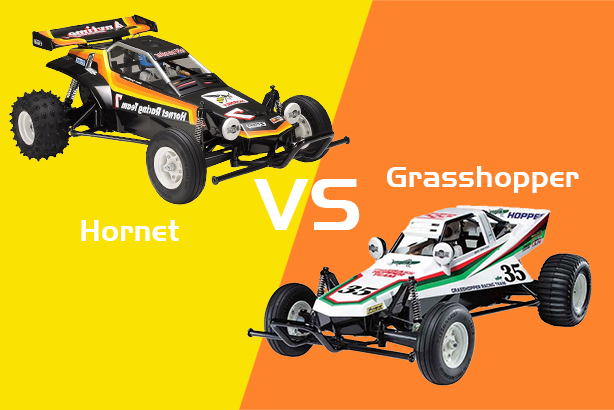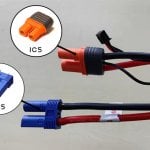In 1984 Tamiya introduced two classic 1/10 scale RC cars – Hornet and Grasshopper, and they are still great products to this day. In fact, most of their components are similar, but there are big differences in the details. Which is better, Hornet or Grasshopper?
If you are very interested in this question, then the long answer below is where I compare them in detail.
Compare basic parameters
| Car | Hornet | Grasshopper |
| Speed | 43.4Mph | 11Mph |
| Suspension Type | High Performance | Pivoting Rear Axle with a Springy Feel |
| Motor | RS 540 | 380 |
| Shocks | Oil-filled rear dampers | coil spring dampers |
| Body material | ABS resin bathtub frame | bathtub resin monocoque chassis |
| Size (L*W*H) | 400m*230mm*150mm | 389mm*223mm*135mm |
| Weight | 874g | 830g |
| Rear tires | Spiked buggy rear tires | Paddle-style rear tires |
| Cost | $223 | $136 |
| Batteries | 7.2v NiMH | 7.2v NiMH |
We can think of Hornet as an upgraded version of Grasshopper. They are both 2WD and bathtub frame off-road vehicles. In terms of components, they have different body materials, motors, shock absorbers, and suspensions.
Speed: The Hornet uses a 540 motor compared to the Grasshopper’s 380 motor, which makes it much faster than the Grasshopper.
DURABILITY: The Grasshopper’s shell is designed with sturdy ABS plastic instead of the Hornet’s polycarbonate body. In terms of the suspension, the Hornet used a swaying rear axle design, while the Grasshopper used a simple friction shock system that pivoted up and down.
Also, running oil-filled shocks is more maneuverable, especially when landing while jumping.
Tamiya Hornet
The Hornet, Tamiya’s 45th model produced, was one of Tamiya’s iconic and best-selling RC vehicles ever made. The Hornet is a 2WD 1/10 off-road vehicle, released on October 9, 1984, with colors and shapes inspired by the bumblebee.
Pros
- Faster, it tops out at 43.4Mph
- More durable, its component materials are stronger
Cons
- High cost
Since 1984, Tamiya has produced three different Hornet models making the Hornet one of the longest-running Tamiya kits.
- In 2004, Tamiya produced a remake of the Hornet, totally different from the original.
- In 2006, the hobby-grade manufacturers also made the Tamtech-Gear Hornet, a smaller scale, and used an entirely different design from the original Hornet.
- In 2019, Tamiya produced the Comical Hornet, a caricature-style Hornet.
Tamiya Grasshopper
The Grasshopper was introduced in the 1980s, and at the time it was one of the most classic products. Other manufacturers scrambled to emulate the vehicle and launched similar copies.
Pros
- Low cost
- Long run time
Cons
- Passable driving speed
- Not as durable as Hornet
The Grasshopper’s body is sharp and angular, and its color is dominated by white, with red and green stripes embellished. The exterior looks very dynamic. Grasshopper is a budget 2WD 1/10 scale dirt bike Baja perfect for RC beginners.
To date, Grasshopper has undergone two remakes with a different look than the original.
Conclusion
Both the Hornet and Grasshopper are great retro RC cars, but that doesn’t mean they’re obsolete. They’re not high-performance cars compared to today’s cars, but you can collect them. Which one to choose comes down to what you like.



